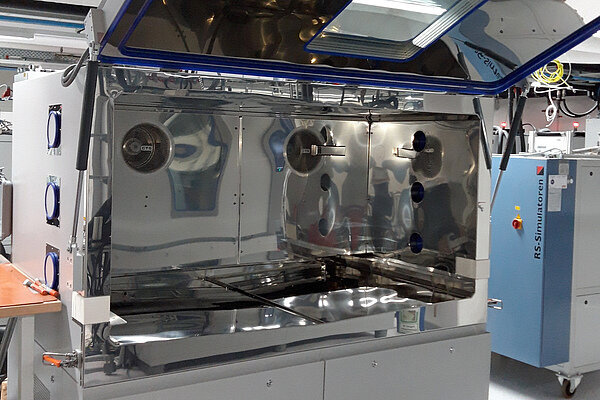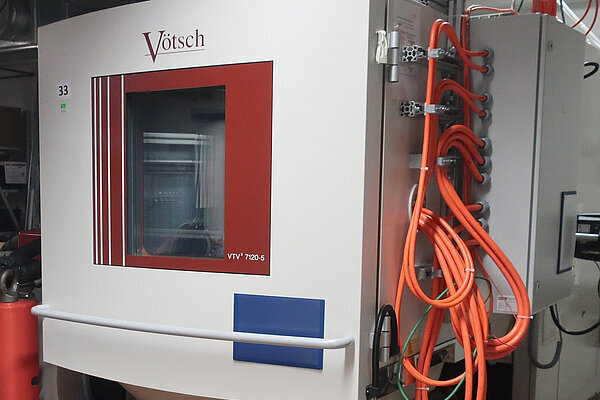Endurance Testing already in the Development Phase
In the exciting field of ever shortening innovation cycles for products on the one hand and constantly increasing expectations of long lifetimes and reliability on the other hand, assurance of an applicable lifetime takes on special significance already during the development phase of a product.
Here, so-called Environmental and Endurance Testing are applied, which accelerate the aging process and failure mechanisms of technical products in a controlled manner with targeted stress impacts, thus being able to make reliable statements possible about the defined lifetime under normal conditions. From this, at best, possible design interventions are shown for the elimination of vulnerabilities/weak points prior to market introduction. Looking at product liability and image damage, this is a market advantage that in the long-term cannot be underestimated.
Expertise in Environmental Simulation since 2003
Thus today Zollner Elektronik AG offers its global customers comprehensive environmental and endurance testing with the applicable know-how in the area of product certification at a testing area larger than 1,000m². Numerous sectors will be served, such as Automotive, Healthcare & Life Sciences, Measurement Technology as well as Aerospace and Defense and Rail Technology. Through internal tests and close cooperation with renowned certification bodies during development, a very high maturity level can be ensured for the customer product.
Basically, environmental influences on products are recreated in the laboratory in simulations, like temperature, moisture, vibration and dust, etc. With this, requirements on the product placed by the customer or standards are tested as to whether they also fulfill them during the defined lifetime. For example, testing is performed to see whether daytime running lights function as planned in the winter at -40°C. That is a typical question that can be verified within the framework of environmental simulation.
The significance of this all-encompassing topic was recognized early by the EMS market leader, and thus the Environmental Simulation Division was born in 2003. Applicable to constantly increasing customer requirements, the division was expanded radically in 2011 so that, today, more than 1,000 m² of testing space exists in the Environmental Testing Center with nearly all of the common environmental and endurance tests available.
Qualitative Environmental and Endurance Testing
The tests most frequently performed are temperature fluctuation tests. Over 25 temperature and climate cabinets are available whose volume reach from 50 to 2,000 liters. Temperatures from -70 °C to +180 °C can be realized in them. Special notch-type access ports make it possible to bring test objects with connected wires into the testing cabinet - a common practice in the Automotive Division.
One special form of temperature fluctuation testing is the thermal shock test. There are several special testing cabinets available for this as well. With the two-chamber principle, test objects can go between two extreme temperatures (e.g.: -40 °C / +125 °C) within 10 seconds. This quick temperature change puts an extreme amount of stress on the test object, particularly the solder joints on a populated PCBA.
Temperature fluctuation testing is often used for endurance testing. With the Coffin-Manson model, the number of temperature cycles can be determined with which the pursued life expectancy can be recreated. Test durations of several weeks and months are the rule here.
In the climate cabinets, in contrast to the temperature cabinets, relative humidity can also be regulated. Thus one can recreate high relative humidity at very high temperatures and stress the test object accordingly. Sometimes targeted dewing can be created at the test object to test behavior.
Vibration testing is a further focal point of environmental simulation. Zollner has four electrodynamic “Shakers” available for this. With them, all common stimulation types can be recreated (sinusoidal, random, sine-on random, mechanical shock). A force vector of 57 kN (sinusoidal) allows for tests of larger masses. Also, the relatively new stimulation type “multi-sine” can also be realized. Here, in one sine sweep, multiple frequencies are tested simultaneously, which allows for a shorter test duration and saves cost.
Vibration testing represents a big challenge for the test object and the test setup. Attachment of the test object should always be identical to the later practical application, otherwise incorrect test results arise quickly, which can lead to incorrect and unnecessary measures.
Vibration tests not only serve product testing itself, but also find application within the framework of transport simulation. Here the focus is on packaging. It is checked whether the test object is suitable for secure transport.
A temperature cabinet is available at all four shakers. Vibration profiles can be overlaid with a temperature profile, which is a common practice in several sectors.
A special test chamber is available for dust testing with a testing volume of 1 m². Dust can be blown in from above or below using compressed air. So-called Arizona test dust is the main dust used. The composition of the test dust is defined in applicable standards, and the main criterion here is the size of the individual dust particles, which reach from less than 1 µm to 100 µm. Dust testing is also a part of IP protection type testing. It is tested here whether dust penetrates housings and causes malfunctions.
The impacts of a salty atmosphere, as it exists close to the ocean or as a result of the use of road salt in the winter, can be recreated in the Salt Spray Chamber. To do this, air is fed through an ultra-pure, 5% sodium chloride solution and then sprayed into the test chamber.
The Splash Water Chamber predominantly serves the Automotive Division. With it the abrupt cooling of closed components with water is simulated, like it can occur when driving through puddles. The test object is heated in a test chamber to 105 °C and then splashed at suspected weak points for several seconds with cold water. This process is repeated many times.
The environmental simulation equipment in the Analysis and Materials Technology Division provide a basis for Zollner to be able to produce innovative, high-value and safe systems. As a Swiss EMS company within the Zollner Group, Zollner Electronics GmbH can offer these services to its customers and with that make a contribution to a sustainably high level of quality across the entire product life cycle.

